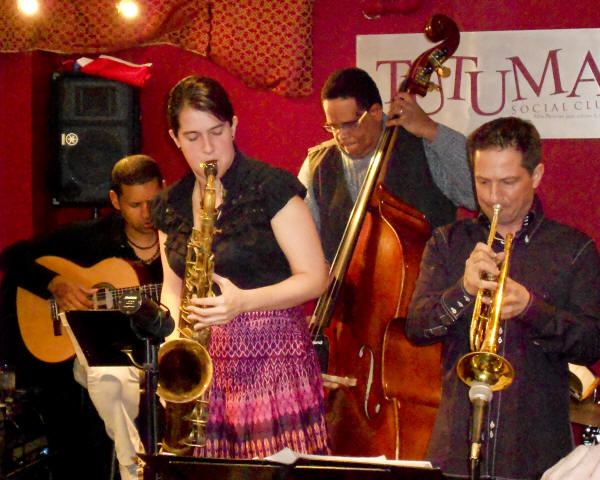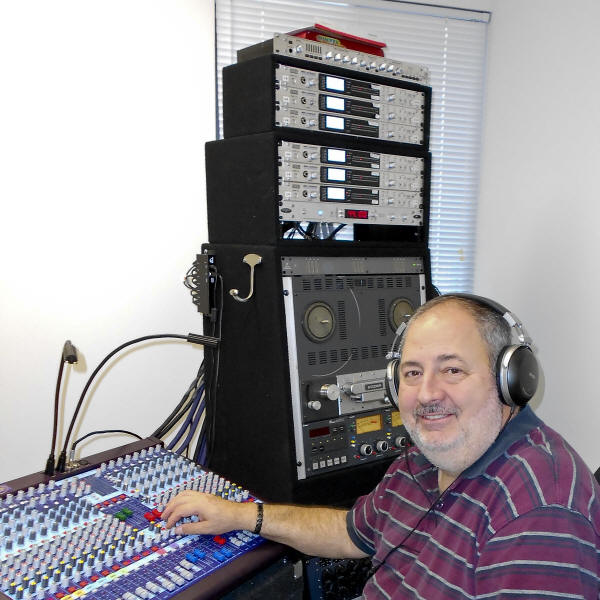|
You are reading the older HTML site
Positive Feedback ISSUE 60
Can Recordings be Better than Live?
Tutuma Social Club Not so many moons ago, I had occasion to attend a jazz performance at the Tutuma Social Club here in NYC. The invitation came from Joe Kubala, the cable guy, who was going to record that evening's sets. (Kubala-Sosna does recordings for the BluePort Jazz label.) The Tutuma Social Club's main purpose is to promote all things from Peru, from cuisine to indigenous music. The night we attended the Gabriel Alegria Afro-Peruvian Sextet was performing. The smallish house only seats 50, with standing room for another 20, and the band has many fans. It was packed. I remember the welcoming atmosphere, the surprisingly ambitious and mostly successful regional cuisine, and the sizzling energy, both on stage and off—and the performance. An eclectic bunch of musicians, some quite young, assembled on the small stage, vying for space. Things did not appear auspicious. (I admit to a bias against young musicians. You have to be around for a while to have something to say, right?) Then they began to play and it was like, "Holy cow! She did that with the tenor sax?"
Sextet It was a great set, but the acoustical problems were overwhelming. I can't say I was thrilled with the live sound. Issue #1: In a 30' x 60' x 8' room, a drum kit will make your ears sizzle. There is no need for a tenor sax or trumpet to be amplified in a hall this size. Of course, the SPLs overloaded the room. Issue #2: Balance issues prevented the occasional vocalist from being heard. Issue #3: There were also audience intrusions. Hyper fans invaded the stage area to take cell phone pictures, occasionally bumping into mike stands and knocking them out of position. As much as I liked the band, I wouldn't be coming back to hear them in this club. Afterwards, Joe invited us to take a "peak" through his headphones at what he laid down on the master. Hmm… it sounded better than live. Yes, the evening left me with vivid, multi-faceted impressions, both positive and negative. Present Time Then last week another invitation came along, this time for a boys' night out to check out the reference system in K-S's new office space. Joe began with Red Book over a Naim server, and then moved to vinyl. Some time later, the idea of playing back the Tutuma tape came up. As Joe's mixing/mastering room abuts the sound room, he was able to patch in the master DSD file into his Soulution 720 preamp via a 110' interconnect. That's when the time warp opened up. The crackling excitement and feel of the live event were re-created in the playback. I was suddenly back in the Tutuma Social Club that rainy night last fall. However, there was a major difference: Somehow, the overloading and consequent distortion on peak SPLs was eliminated; dynamics flowed naturally and without compression; and the balance issues and audience intrusions were gone. The sound was uncompromised in any way, an audiophile's ideal, and in this sense it was better than being there. The demo of Joe's system bifurcated into a "Before" (when he used conventional sources, i.e. CD and LP), and "After" (with the master tape).
Joe mastering Can Recordings be Better than Live? How can recordings be better than live? Have we gone too far? In this context, what does it mean to talk about "the absolute sound"? Ouch! Too many philosophical hot potatoes here—I'm not going to touch them. How about rephrasing the question to "What would make the repro sound better than live?" Now an explanation becomes possible. Format is certainly a big factor. Joe used multiple Korg MR2000 machines to record in what is known as "double DSD." This digital format has 128 times the samples or information slices of Red Book CD and, most importantly, has the feeling of analog—and we all know that analog is the gold standard. If you buy into the theory that what ails digital are the dead spots between the slices, then filling in the gaps is the Rx. Joe says if he had recorded with ¼" analog tape at 15 inches per second, it would have been just as good, although it would have sounded different. So, a high-res format is desirable, but that alone does not guarantee this level of serendipity. When you think about it, engineering a recording presents just as many choices and considerations as an audiophile faces in assembling a sound system or a sound room. Other than format, while on location, the engineer has to make decisions, such as:
Those decisions are fixed at the time of the recording—nothing can change them. Back in the studio, post-production offers some opportunity to adjust things like:
In pop and rock it is not at all uncommon for the repro to sound much better than live. This has been the case for years. Now it is within our reach to make similar claims regarding recordings geared for the audiophile market. Please keep in mind that the presentation retains soundstage cues and the relationship among instruments, but it's now from the perspective of the mikes. Tonal balance, timbral accuracy, dynamics, and pace have been preserved from the original. What has changed is the hall contribution—potentially all of its compromises have been taken out of the picture. Given that, and the impossibility of recreating the live event, don't we owe it to ourselves to optimize playback with any tools at our disposal? I look forward to the next K-S "master tape recording" issued under the BluePort label. Perhaps an SACD—or even an LP. Why not?
|



